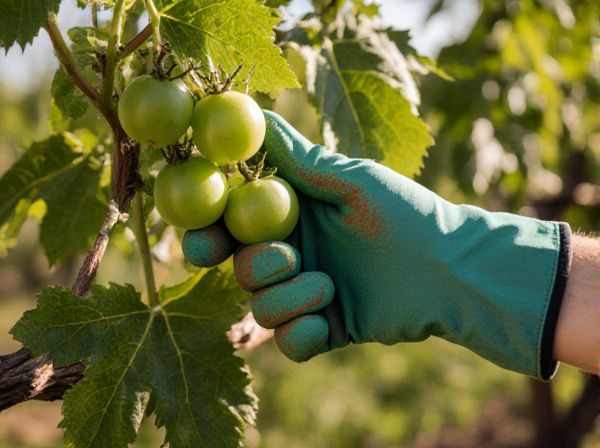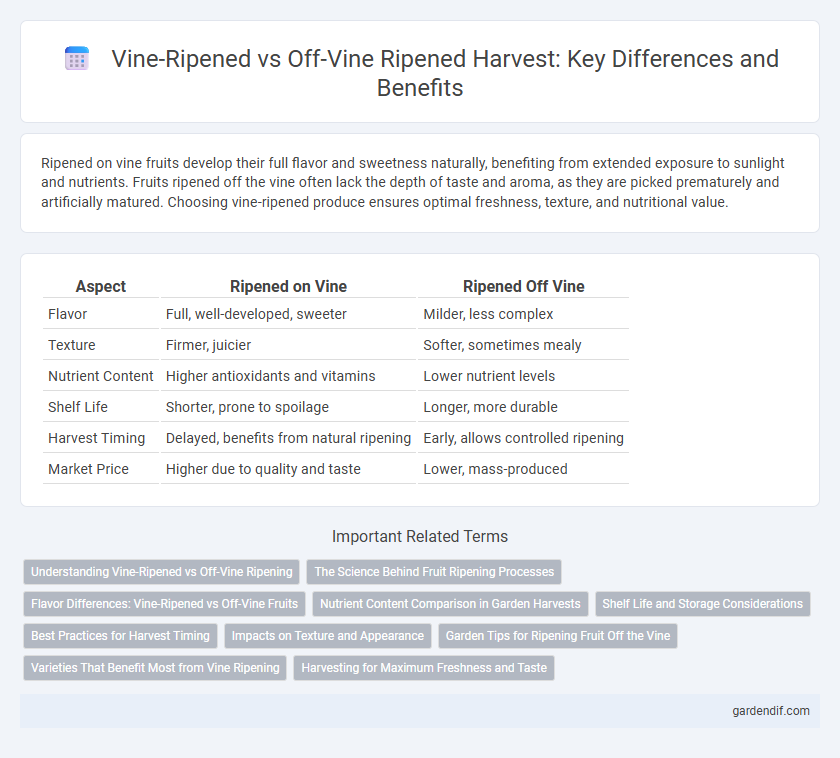
Ripened on Vine vs Ripened Off Vine Illustration
Ripened on vine fruits develop their full flavor and sweetness naturally, benefiting from extended exposure to sunlight and nutrients. Fruits ripened off the vine often lack the depth of taste and aroma, as they are picked prematurely and artificially matured. Choosing vine-ripened produce ensures optimal freshness, texture, and nutritional value.
Table of Comparison
| Aspect | Ripened on Vine | Ripened Off Vine |
|---|---|---|
| Flavor | Full, well-developed, sweeter | Milder, less complex |
| Texture | Firmer, juicier | Softer, sometimes mealy |
| Nutrient Content | Higher antioxidants and vitamins | Lower nutrient levels |
| Shelf Life | Shorter, prone to spoilage | Longer, more durable |
| Harvest Timing | Delayed, benefits from natural ripening | Early, allows controlled ripening |
| Market Price | Higher due to quality and taste | Lower, mass-produced |
Understanding Vine-Ripened vs Off-Vine Ripening
Vine-ripened fruits develop maximum natural sugars, flavor complexity, and nutrient density due to extended exposure to sunlight and photosynthesis. Off-vine ripened fruits rely on artificial ripening agents like ethylene gas, often resulting in less intense flavor and lower nutritional value. Understanding these differences is crucial for selecting produce with optimal taste and health benefits.
The Science Behind Fruit Ripening Processes
Fruit ripening on the vine involves complex biochemical processes triggered by ethylene production and enzymatic changes, enhancing sugar content and flavor compounds while maintaining cellular integrity. Off-vine ripening relies on controlled post-harvest ethylene exposure and temperature regulation to stimulate similar metabolic pathways, though often resulting in differences in texture and taste. Understanding these physiological and molecular mechanisms helps optimize harvest timing and storage conditions for maximum fruit quality and shelf life.
Flavor Differences: Vine-Ripened vs Off-Vine Fruits
Vine-ripened fruits develop complex sugars and nuanced flavors due to prolonged exposure to natural sunlight and nutrient absorption, resulting in richer sweetness and enhanced aroma. Off-vine ripened fruits, often harvested early and artificially matured, typically lack the depth of flavor and may exhibit a starchier texture with less vibrant taste profiles. The biochemical processes activated during on-vine ripening influence the synthesis of volatile compounds, significantly impacting the fruit's overall flavor quality.
Nutrient Content Comparison in Garden Harvests
Fruits and vegetables ripened on the vine typically exhibit higher nutrient content, including increased levels of vitamins C and A, compared to those ripened off the vine. This enhanced nutrient density results from the continued photosynthesis and natural sugar accumulation while still attached to the plant. Off-vine ripening, often accelerated using ethylene gas, can lead to a decrease in antioxidant levels and overall flavor quality in garden harvests.
Shelf Life and Storage Considerations
Fruits ripened on the vine develop fuller flavor profiles and tend to have a longer shelf life due to natural maturation processes enhancing their cellular structure and nutrient content. In contrast, fruits ripened off the vine often require controlled environments with specific temperature and humidity settings to prevent premature spoilage and maintain firmness. Proper storage considerations, such as refrigeration for vine-ripened produce and ethylene management for off-vine ripened fruits, are critical to optimizing freshness and extending shelf life.
Best Practices for Harvest Timing
Harvest timing significantly influences grape quality, with ripened on vine grapes developing optimal sugar levels, acidity balance, and phenolic maturity essential for premium wine production. Grapes ripened off vine, often harvested early, may lack full flavor development and complex aromas, affecting wine complexity and aging potential. Best practices emphasize monitoring Brix, pH, and tannin ripeness in vineyard to determine the ideal harvest window, ensuring peak fruit quality and consistency for superior vinification outcomes.
Impacts on Texture and Appearance
Ripened on vine fruits develop a firmer texture and richer color due to the natural accumulation of sugars and chlorophyll during the ripening process. Fruits ripened off vine often exhibit a softer, less consistent texture and duller appearance because they lack the full biochemical changes induced by sunlight and nutrient flow from the plant. These differences impact consumer perception and shelf life, with vine-ripened produce generally preferred for freshness and visual appeal.
Garden Tips for Ripening Fruit Off the Vine
Fruits ripened off the vine require careful temperature control around 65-75degF and indirect sunlight to promote even softening and flavor development. Storing fruits like tomatoes and peaches in breathable containers or paper bags can help trap ethylene gas, accelerating the ripening process while preventing mold growth. Avoid refrigeration until fruits fully ripen to maintain optimal sugar content and texture for garden harvests.
Varieties That Benefit Most from Vine Ripening
Tomatoes, grapes, and peppers are among the varieties that benefit most from ripening on the vine, as this process enhances their sugar content, flavor complexity, and nutritional value. Vine ripening allows for extended exposure to sunlight and nutrients, leading to a richer taste profile and improved texture compared to those ripened off the vine. Harvesting these fruits at peak maturity ensures optimal quality, making vine ripening crucial for premium crop production.
Harvesting for Maximum Freshness and Taste
Harvesting fruits and vegetables when ripened on the vine ensures peak freshness and optimal flavor due to natural nutrient development and extended sun exposure. Conversely, items ripened off the vine may lack full flavor intensity and nutrient density because they mature post-harvest, often under controlled conditions. Prioritizing vine-ripened produce maximizes taste profiles, nutrient retention, and overall quality at harvest time.
Ripened on Vine vs Ripened Off Vine Infographic

 gardendif.com
gardendif.com